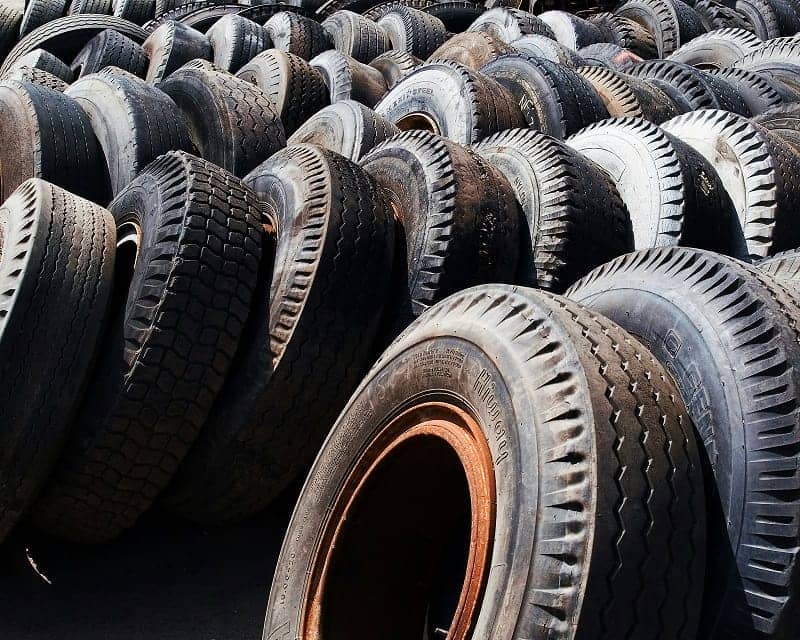Recycling is commonly represented as three arrows forming a triangle. Each arrow turns a corner, representing a stage in the material’s life cycle. The arrows run back into each other, indicating that the process is circular and can continue indefinitely. While this is a beautiful symbol, its simplicity can fail to represent the true challenges and genius in the recycling industry.
Many materials can eventually be fully recycled indefinitely. Cans and glass are two great examples. However, the majority of materials can only be remade into parts of the original. For example, most plastics can only be recycled two or three times before their quality becomes too poor for resale. Worn-out tires are even more difficult to recycle into new tires than many products. This is because tire rubber is vulcanized.
What is vulcanization?
Natural and synthetic rubber must undergo a chemical change to make them suitable for tires. This process, known as vulcanization, links polymer chains and increases the stability and durability of the rubber. This process was discovered and named after Vulcan, the Roman god of fire, by Charles Goodyear in the 1800s. It was named after the god of fire because superheating rubber is the primary step in vulcanization.
The vulcanization process typically involves heating rubber with sulfur and other additives under controlled conditions. Similar to the different oven times required to bake various breads.
The exact method varies depending on the desired properties of the final product. Race car tires need to be soft in order to maintain maximum traction, so they are heated at higher temperatures for less time.
The cross-linking of polymer chains sounds complex, but the result is what matters. The cross-linking makes the rubber more brittle and three-dimensionally sound, significantly improving the rubber’s mechanical properties. Vulcanized rubber is more resistant to heat, wear, and chemicals. It also enhances elasticity and strength, reducing tackiness and susceptibility to aging and environmental degradation.
Vulcanization is essential in manufacturing various rubber products, including tires, conveyor belts, hoses, seals, gaskets, and shoe soles. The process has revolutionized industries reliant on rubber by enabling the production of more durable and versatile materials suitable for a wide range of applications.
One easy way to think of vulcanization is like boiling an egg. Heating up the whites and yolk changes their properties from a goopy mess to a delicious sandwich or salad addition. Ever tried changing a cooked egg back into a fresh egg? Good luck.
Vulcanized Rubber and Tire Recycling
So, what does vulcanized rubber mean for tire recycling? Well, it presents a bit of a challenge. While rubber recycling plants can recycle tires, they can’t be fully remade into new tires due to the vulcanization process. Instead, tire recyclers transform them into various products, such as rubberized asphalt, playground surfaces, or fuel.
The challenge lies in breaking down the vulcanized rubber into its raw materials for reuse. Unlike glass or aluminum, which can be melted down and reshaped, vulcanized rubber retains its cross-linked structure even after recycling. However, innovative rubber recycling machinery is constantly being developed to find new ways to recycle and repurpose tire rubber efficiently.
In essence, vulcanized rubber adds complexity to tire recycling, but it also sparks creativity and innovation in finding sustainable solutions for repurposing tire rubber. While we may not be able to turn old tires back into new tires, we can still give them a new lease on life in other useful applications.
True sustainability has many aspects. Often, more important than the recyclability of a product is the product’s lifespan. Vulcanizing tire rubber makes tires as durable and long-lasting, which means consumers need fewer tires overall, and tire manufacturers use less energy.
The Importance of Responsible Tire Disposal
Considering how vulcanization creates extremely durable rubber, proper tire disposal is crucial for environmental sustainability and public safety. Tires disposed of improperly can become breeding grounds for pests like mosquitoes, contributing to public health risks. When tires pile up, they pose fire hazards and leach harmful chemicals into the soil and waterways.
To reduce these risks, it’s essential to encourage tire recycling and proper disposal practices. Many countries have tire recycling programs in place, offering options for tire drop-off locations or curbside collection. By participating in these programs, individuals can help divert tires from landfills and support the creation of valuable recycled products.
Innovative approaches such as pyrolysis, which involves heating tires without oxygen to produce oil, gas, and char, offer promising avenues for tire recycling. Continued investment in research and development can lead to further advancements in tire recycling technologies, promoting a sustainable and circular economy.
While vulcanized rubber presents challenges in tire recycling, it also increases tire lifespan, inspires innovation, and drives progress toward sustainable solutions. By recognizing the importance of responsible tire disposal and supporting tire shredder businesses, we can minimize environmental impact and make the most of the vulcanized rubber required to help our society run.
